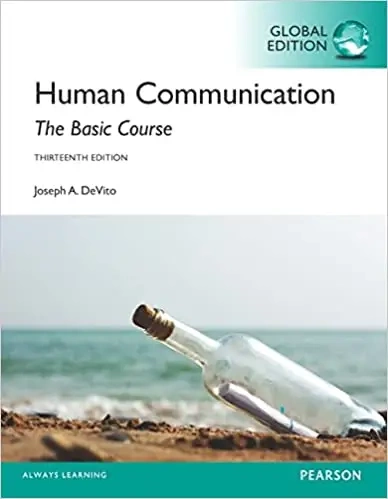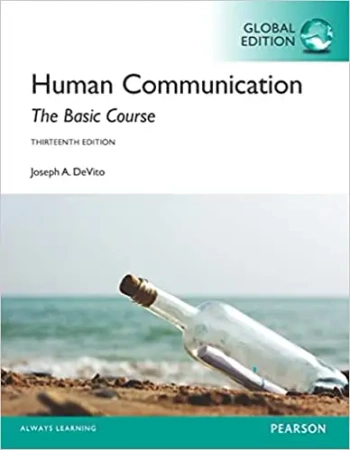Human Communication. The Basic Course. Global Edition - Joseph A. DeVito
Description
Provides a thorough foundation in the theory, research, and skills of communication
Human Communication: The Basic Course provides an in-depth look at the concepts and principles of human communication, emphasizing public speaking, interpersonal communication, and small group communication. Designed to allow flexibility in teaching approaches, Human Communication: The Basic Course offers instructors a wide range of topics to discuss and apply to real-world experiences.
Features
- Covers the Fundamentals of Communication - Part One covers the fundamental concepts and principles of human communication, the self and perception, listening and verbal and nonverbal messages. Part Two covers interpersonal interaction and relationships, small group membership and leadership, organizational communication, and conflict. Part Three covers the preparation and presentation of public speeches.
Emphasizes the Concept of Choice - The concept of choice as central to all communication has been given greater prominence in this edition.
Includes Coverage of Public Speaking - Five full chapters devoted to Public Speaking help students develop the skills needed for informative, persuasive, and special occasion speaking.
Discusses Cultural Issues - An entire chapter (Chapter 2) devoted to cultural issues explains the ways culture and gender influence communication, and integrated coverage throughout the text relates cultural and gender issues to all aspects of human communication.
Focuses on Communication Competence– Critical thinking questions, key terms, and summaries enable students to practice concepts learned in each chapter. In this edition, the self-tests have been integrated into the text narrative. Reflections on Ethics, Understanding Theory and Research, and Media Literacy boxes contain experiences designed to encourage readers to interact with the concepts and to relate these insights to their own everyday communication.
New to this Edition
- The chapter-opening objectives have been restructured into behavioral terms and highlight knowledge, application, and problem solving. The chapter-opening grid identifies these alongside the chapter’s major headings/topics (which are repeated in the summary headings at the end of the chapter). This change helps coordinate the learning objectives and the chapter material and phrases the objectives in behavioral, measurable terms.
The sample speeches in the public speaking chapters, formerly in boxes in the chapters, have been moved to a Public Speaking Sample Assistant Appendix. This change makes the text flow more smoothly and makes the speeches available whenever most appropriate. The outlines remain in the text chapter.
The self-tests, formerly in boxes, have been integrated into the text narrative. This change was made to make these self-reflections a more integrated and integral part of the text.
The Building Communication Skills boxes, from the previous edition, have been moved to the end of the chapters and now preface a variety of exercises and discussion starters. This change increases flexibility, making these features available at any point in the chapter coverage.
The videos, formerly presented as chapter openers, now appear as the last item in the chapter. This change was made to emphasize the value of using these videos after the chapter material has been covered. This change also enabled us to brighten up the chapter openers with new photos that illustrate principles of communication from very different perspectives.
Content Changes
In addition to an updating of research, new examples, greater emphasis on social media, new exercises, and improved graphics, among the major content changes are these:
Part One: Foundations of Human Communication (Chapters 1-6)
New discussions of media literacy and choice making as characteristics of communication competence, a media literacy box on media imperialism, a table on the metaphors of culture, discussions of dialects and accents, online social comparisons, self-disclosure in the workplace, the impostor phenomenon, onymous and anonymous messages, and interpersonal time.
New “In a Nutshell” tables summarize the principles of human communication, the competent communicator, improving intercultural communication, guidelines for self-disclosure, impression formation processes and strategies, listening styles, principles of verbal messages, and proxemic distances.
Part Two: Interpersonal, Small Group, and Organizational Communication (Chapters 7-13)
New materials include a self-test on small talk, politeness as a principle of conversation, an exercise on introductions, and discussions of types of families, the intervention group, social loafing, and the transition from membership to leadership.
New “In a Nutshell” tables summarize the principles of conversation, relationship theories, small group types, membership, and leadership.
Part Three: Public Speaking (Chapters 14-18)
Three new speeches with annotations and new excerpts to illustrate the various principles of public speaking.
Extensively revised sections include those on finding topics, research, voice, and bodily action.
“In a Nutshell” tables discuss the principles of informative speaking and the types of persuasive speaking.
Table of Contents
Part 1. Foundations of Human Communication
Chapter 1. Preliminaries to Human Communication
Chapter 2. Culture and Communication
Chapter 3. The Self and Perception
Chapter 4. Listening in Human Communication
Chapter 5. Verbal Messages
Chapter 6. Nonverbal Messages
Part 2. Interpersonal, Small Group, and Organizational Communication
Chapter 7. Interpersonal Communication: Conversation
Chapter 8. Interpersonal Relationship Stages and Theories
Chapter 9. Friends, Lovers, and Families
Chapter 10. Small Group Communication
Chapter 11. Members and Leaders
Chapter 12. Human Communication in the Workplace: Organizational Communication
Chapter 13. Interpersonal, Group, and Workplace Conflict
Part 3. Public Speaking
Chapter 14. Public Speaking Topics, Audiences, and Research
Chapter 15. Supporting and Organizing Your Speech
Chapter 16. Style and Delivery in Public Speaking
Chapter 17. The Informative Speech
Chapter 18. The Persuasive Speech
Appendix: Public Speaking Sample Assistants
EAN: 9781292057101




Description
Provides a thorough foundation in the theory, research, and skills of communication
Human Communication: The Basic Course provides an in-depth look at the concepts and principles of human communication, emphasizing public speaking, interpersonal communication, and small group communication. Designed to allow flexibility in teaching approaches, Human Communication: The Basic Course offers instructors a wide range of topics to discuss and apply to real-world experiences.
Features
- Covers the Fundamentals of Communication - Part One covers the fundamental concepts and principles of human communication, the self and perception, listening and verbal and nonverbal messages. Part Two covers interpersonal interaction and relationships, small group membership and leadership, organizational communication, and conflict. Part Three covers the preparation and presentation of public speeches.
Emphasizes the Concept of Choice - The concept of choice as central to all communication has been given greater prominence in this edition.
Includes Coverage of Public Speaking - Five full chapters devoted to Public Speaking help students develop the skills needed for informative, persuasive, and special occasion speaking.
Discusses Cultural Issues - An entire chapter (Chapter 2) devoted to cultural issues explains the ways culture and gender influence communication, and integrated coverage throughout the text relates cultural and gender issues to all aspects of human communication.
Focuses on Communication Competence– Critical thinking questions, key terms, and summaries enable students to practice concepts learned in each chapter. In this edition, the self-tests have been integrated into the text narrative. Reflections on Ethics, Understanding Theory and Research, and Media Literacy boxes contain experiences designed to encourage readers to interact with the concepts and to relate these insights to their own everyday communication.
New to this Edition
- The chapter-opening objectives have been restructured into behavioral terms and highlight knowledge, application, and problem solving. The chapter-opening grid identifies these alongside the chapter’s major headings/topics (which are repeated in the summary headings at the end of the chapter). This change helps coordinate the learning objectives and the chapter material and phrases the objectives in behavioral, measurable terms.
The sample speeches in the public speaking chapters, formerly in boxes in the chapters, have been moved to a Public Speaking Sample Assistant Appendix. This change makes the text flow more smoothly and makes the speeches available whenever most appropriate. The outlines remain in the text chapter.
The self-tests, formerly in boxes, have been integrated into the text narrative. This change was made to make these self-reflections a more integrated and integral part of the text.
The Building Communication Skills boxes, from the previous edition, have been moved to the end of the chapters and now preface a variety of exercises and discussion starters. This change increases flexibility, making these features available at any point in the chapter coverage.
The videos, formerly presented as chapter openers, now appear as the last item in the chapter. This change was made to emphasize the value of using these videos after the chapter material has been covered. This change also enabled us to brighten up the chapter openers with new photos that illustrate principles of communication from very different perspectives.
Content Changes
In addition to an updating of research, new examples, greater emphasis on social media, new exercises, and improved graphics, among the major content changes are these:
Part One: Foundations of Human Communication (Chapters 1-6)
New discussions of media literacy and choice making as characteristics of communication competence, a media literacy box on media imperialism, a table on the metaphors of culture, discussions of dialects and accents, online social comparisons, self-disclosure in the workplace, the impostor phenomenon, onymous and anonymous messages, and interpersonal time.
New “In a Nutshell” tables summarize the principles of human communication, the competent communicator, improving intercultural communication, guidelines for self-disclosure, impression formation processes and strategies, listening styles, principles of verbal messages, and proxemic distances.
Part Two: Interpersonal, Small Group, and Organizational Communication (Chapters 7-13)
New materials include a self-test on small talk, politeness as a principle of conversation, an exercise on introductions, and discussions of types of families, the intervention group, social loafing, and the transition from membership to leadership.
New “In a Nutshell” tables summarize the principles of conversation, relationship theories, small group types, membership, and leadership.
Part Three: Public Speaking (Chapters 14-18)
Three new speeches with annotations and new excerpts to illustrate the various principles of public speaking.
Extensively revised sections include those on finding topics, research, voice, and bodily action.
“In a Nutshell” tables discuss the principles of informative speaking and the types of persuasive speaking.
Table of Contents
Part 1. Foundations of Human Communication
Chapter 1. Preliminaries to Human Communication
Chapter 2. Culture and Communication
Chapter 3. The Self and Perception
Chapter 4. Listening in Human Communication
Chapter 5. Verbal Messages
Chapter 6. Nonverbal Messages
Part 2. Interpersonal, Small Group, and Organizational Communication
Chapter 7. Interpersonal Communication: Conversation
Chapter 8. Interpersonal Relationship Stages and Theories
Chapter 9. Friends, Lovers, and Families
Chapter 10. Small Group Communication
Chapter 11. Members and Leaders
Chapter 12. Human Communication in the Workplace: Organizational Communication
Chapter 13. Interpersonal, Group, and Workplace Conflict
Part 3. Public Speaking
Chapter 14. Public Speaking Topics, Audiences, and Research
Chapter 15. Supporting and Organizing Your Speech
Chapter 16. Style and Delivery in Public Speaking
Chapter 17. The Informative Speech
Chapter 18. The Persuasive Speech
Appendix: Public Speaking Sample Assistants
EAN: 9781292057101

